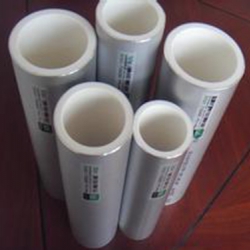PPR pipe and fittings
Compared with traditional cast iron pipe, galvanized steel pipe and cement pipe, PPR pipe has the advantages of energy saving, environmental protection, light weight, high strength, corrosion resistance, smooth inner wall without scaling, simple construction and maintenance, and long service life. Widely used in construction water supply and drainage, urban and rural water supply and drainage, urban gas, power and cable sheathing, industrial fluid transportation, agricultural irrigation and other construction, municipal, industrial and agricultural fields. In recent years, with the increasing market demand in the construction industry, municipal engineering, water conservancy engineering, agriculture and industry, China's PPR pipe industry has shown a rapid development trend. According to the survey, the production volume of plastic pipes in 2009 was 5.804 million tons, an increase of 18.9%. From January to September 2010, the production volume of plastic pipes was 5.528 million tons, an increase of 28.23%. At the same time, with the continuous improvement of consumers' quality requirements for environmental protection, health and durability of products, China's plastic pipes are increasing in output, while the quality of products is continuously improving. The technological progress of the industry is accelerating, and the number of enterprises of brand scale is increasing. The variety of materials and new structures is constantly emerging, and advanced system design concepts are emerging one after another. The functionality of the products is more obvious and the application fields are further broadened. According to the analysis, the proportion of China's plastic pipe market share in all pipelines has exceeded 30%. By 2015, in the new construction, reconstruction and expansion projects in the country, 85% of the construction drainage pipelines use plastic pipes, 80% of the construction rainwater drainage pipes use plastic pipes, and the plastic pipes of urban drainage pipes use 50%, building water supply and hot water. 85% of supply and heating pipes use plastic pipes, 80% of urban water supply pipes (below DN400mm) use plastic pipes, 90% of village water supply pipes use plastic pipes, and urban gas plastic pipes (medium and low-pressure pipes) use 40%, construction wires 90% of the threading sheath tube is made of plastic tube. It is predicted that during the 12th Five-Year Plan period, China's plastic pipe production will maintain a growth rate of around 10%. By 2015, the national plastic pipe production volume is expected to be close to 12 million tons. The market share of plastic pipes in various types of pipelines in the country exceeds 60%. The PPR pipe is officially called the random copolymer polypropylene pipe, which is the most widely used water supply pipe in the home improvement project. PPR pipe material quality control problem, PPR is a random copolymerized polypropylene synthesized by (PP and PE) gas phase method, its structural characteristics are that PE molecules are randomly linked in PP molecules, and the molecular weight ranges from 300,000 to 800,000. . Pipes produced from PPR raw materials, also known as random copolymer polypropylene pipes, are plastic pipe products developed in the late 1980s and early 1990s. With its excellent performance and wide application fields, it has occupied a place in the plastic pipe market and is recognized as a green product. However, in recent years, the market operation, the above PPR plastic pipe quality problem analysis examples have found that there are many problems in the PPR pipe market, these problems have largely restricted the benign development of PPR pipe.
PPR pipe connection technology:
Generally no more water leakage, and the reliability is extremely high. However, this does not mean that the PPR water pipe is a water pipe with no defects. It has high temperature resistance and pressure resistance. The long-term working temperature cannot exceed 70 °C. Each length is limited and cannot be bent. If the pipe is laid for a long distance or at a corner Many, a large number of joints are used in construction; pipes are cheap but the price of accessories is relatively high. In terms of comprehensive performance, PPR pipe is a cost-effective pipe, so it has become the material of choice for home improvement.
Common colors of PPR tube:
The PPR tubes sold in the market mainly have the following colors, white, gray, green and curry colors. Why is there such a difference, mainly due to the difference in the color masterbatch of the PP-R tube. It is generally recommended to buy a white PPR tube, because a very small number of manufacturers who want to smoke their hearts will use recycled materials to produce PPR tubes, and by adding color masterbatch to cover the defects caused by impure raw materials.
PPR pipe installation recommendations:
Generally, in the hydropower transformation, the original water pipes will be replaced. The home improvement company and the merchants all choose hot water pipes when installing the PPR pipes, even hot water pipes are used in places where cold water flows. Their argument is that the technical parameters of the hot water pipe are higher than the cold water pipe, and the price is not much different, so the waterway transformation uses hot water pipes.
The diameter of the pipe diameter PPR pipe (according to the outer diameter) can be from 20mm to 160mm, the main use in the home decoration is 20mm (PPR is 4 pipe, which is different from the galvanized pipe), 25mm (PPR is 6 pipe, and galvanized) There are two types of tubes, of which 20mm are used more. If the economy allows, we recommend the use of PPR pipes with an outer diameter of 25 mm, especially the cold water pipes that enter the water, because modern households are highly concentrated, water is more and more, and the probability of water is high. Reduce the water pressure and water flow is small.


